2023 SUBARU BRZ engine
[x] Cancel search: enginePage 247 of 432

Driving Mode Select Switch (If Equipped)
241
Starting and Operating7
– CONTINUED –
7-7. Driving Mode Select Switch (If Equipped)By pressing the driving mode select
switch the following modes can be
selected to suit driving and usage condi-
tions:■ Normal ModeProvides an optimal balance of fuel
economy, quietness, and dynamic perfor-
mance. Suitable for normal driving.■Sport ModeThe Sport mode indicator light comes on.
Use Sport mode for sporty driving or when
driving in mountainous regions with lots of
curves. If the mode is changed to Sport mode
while driving with the select lever in the “D”
position, the selected gear, from “D1” to
“D6”, will be displayed on the meter.
NOTE In Sport mode, lower gears are used
and gears change at a higher engine
speed.
Sport mode cannot be changed to
when driving with adaptive cruise
control/cruise control activated.
While the engine is cool, you cannot
change to Sport mode.
If tire slip is detected on a slippery
road surface while in Sport mode,
Sport mode may be cancelled.■ Snow ModeThe Snow mode indicator light comes on. Use Snow mode for accelerating and
driving on slippery road surfaces such as
snow.
NOTETo prevent slipping, 1st gear cannot be
selected when in Snow mode.■ Driving Mode Select SwitchTo select the Sport mode, press the
SPORT switch.
To select the Snow mode, press the
SNOW switch.
To cancel Sport mode or Snow mode,
press the same side of the switch again.
702776
702777
702775
BRZ_U.book 241 ページ 2022年3月29日 火曜日 午後3時59分
Page 248 of 432
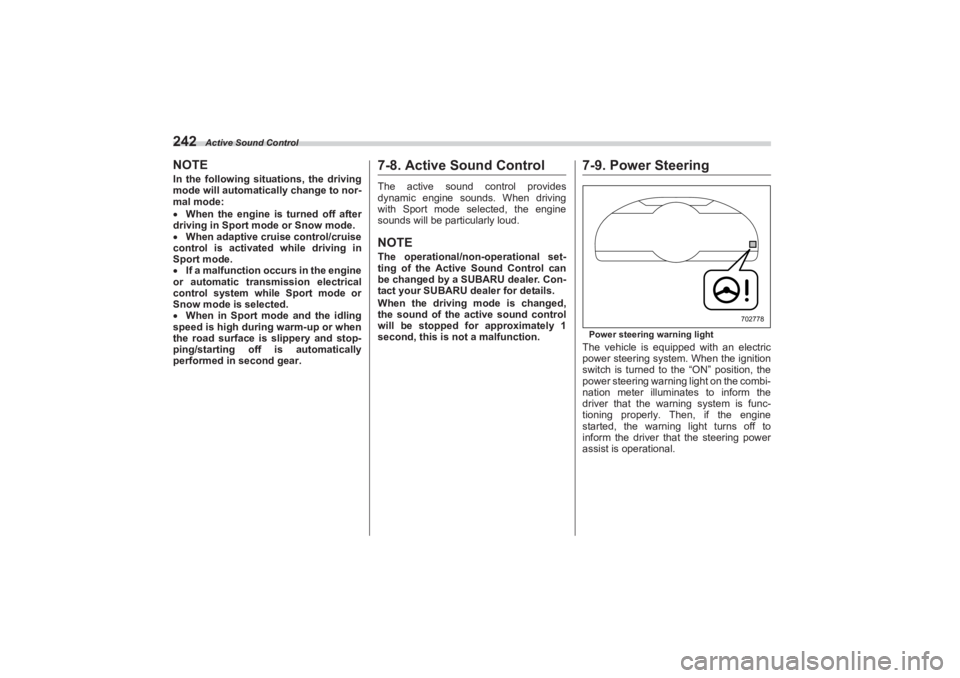
Active Sound Control
242NOTEIn the following situations, the driving
mode will automatically change to nor-
mal mode:
When the engine is turned off after
driving in Sport mode or Snow mode.
When adaptive cruise control/cruise
control is activated while driving in
Sport mode.
If a malfunction occurs in the engine
or automatic transmission electrical
control system while Sport mode or
Snow mode is selected.
When in Sport mode and the idling
speed is high during warm-up or when
the road surface is slippery and stop-
ping/starting off is automatically
performed in second gear.
7-8. Active Sound ControlThe active sound control provides
dynamic engine sounds. When driving
with Sport mode selected, the engine
sounds will be particularly loud.NOTEThe operational/non-operational set-
ting of the Active Sound Control can
be changed by a SUBARU dealer. Con-
tact your SUBARU dealer for details.
When the driving mode is changed,
the sound of the active sound control
will be stopped for approximately 1
second, this is not a malfunction.
7-9. Power SteeringPower steering warning lightThe vehicle is equipped with an electric
power steering system. When the ignition
switch is turned to the “ON” position, the
power steering warning light on the combi-
nation meter illuminates to inform the
driver that the warn ing system is func-
tioning properly. Then, if the engine
started, the warni ng light turns off to
inform the driver that the steering power
assist is operational.
702778
BRZ_U.book 242 ページ 2022年3月29日 火曜日 午後3時59分
Page 249 of 432
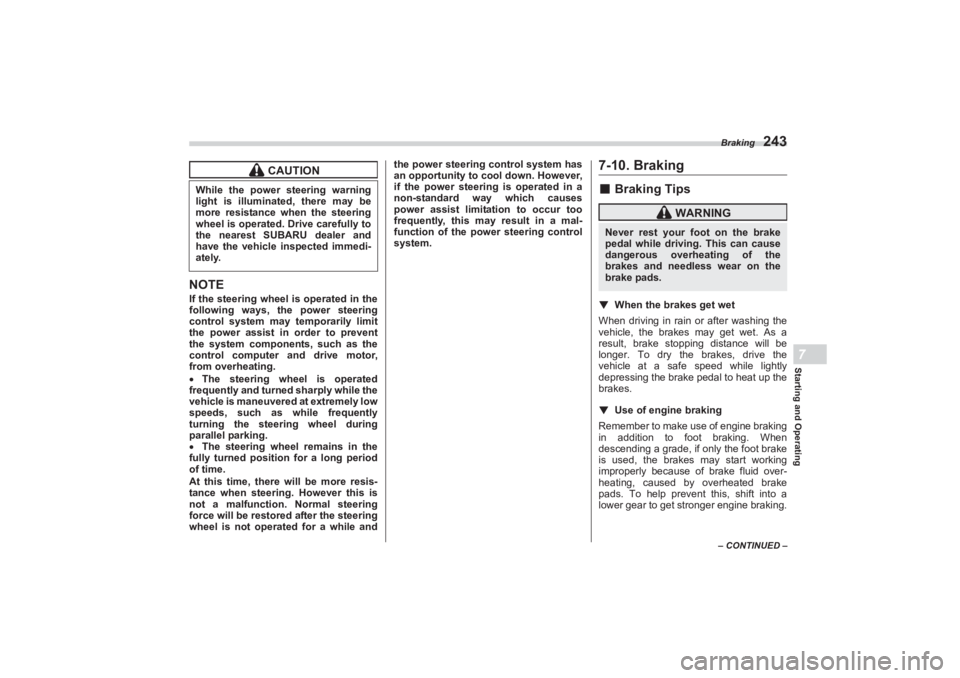
Braking
243
Starting and Operating7
– CONTINUED –
NOTEIf the steering wheel is operated in the
following ways, the power steering
control system may temporarily limit
the power assist in order to prevent
the system components, such as the
control computer and drive motor,
from overheating.
The steering wheel is operated
frequently and turned sharply while the
vehicle is maneuvered at extremely low
speeds, such as while frequently
turning the steering wheel during
parallel parking.
The steering wheel remains in the
fully turned position for a long period
of time.
At this time, there will be more resis-
tance when steering. However this is
not a malfunction. Normal steering
force will be restored after the steering
wheel is not operated for a while and the power steering control system has
an opportunity to cool down. However,
if the power steering is operated in a
non-standard way which causes
power assist limitation to occur too
frequently, this may result in a mal-
function of the power steering control
system.
7-10. Braking■ Braking Tips▼ When the brakes get wet
When driving in rain or after washing the
vehicle, the brakes may get wet. As a
result, brake stopping distance will be
longer. To dry the brakes, drive the
vehicle at a safe speed while lightly
depressing the brake pedal to heat up the
brakes.
▼ Use of engine brakingRemember to make use of engine braking
in addition to foot braking. When
descending a grade, if only the foot brake
is used, the brakes may start working
improperly because of brake fluid over-
heating, caused by overheated brake
pads. To help prevent this, shift into a
lower gear to get stronger engine braking.
CAUTION
While the power steering warning
light is illuminated, there may be
more resistance when the steering
wheel is operated. Drive carefully to
the nearest SUBARU dealer and
have the vehicle inspected immedi-
ately.
WARNING
Never rest your foot on the brake
pedal while driving. This can cause
dangerous overheating of the
brakes and needless wear on the
brake pads.
BRZ_U.book 243 ページ 2022年3月29日 火曜日 午後3時59分
Page 250 of 432
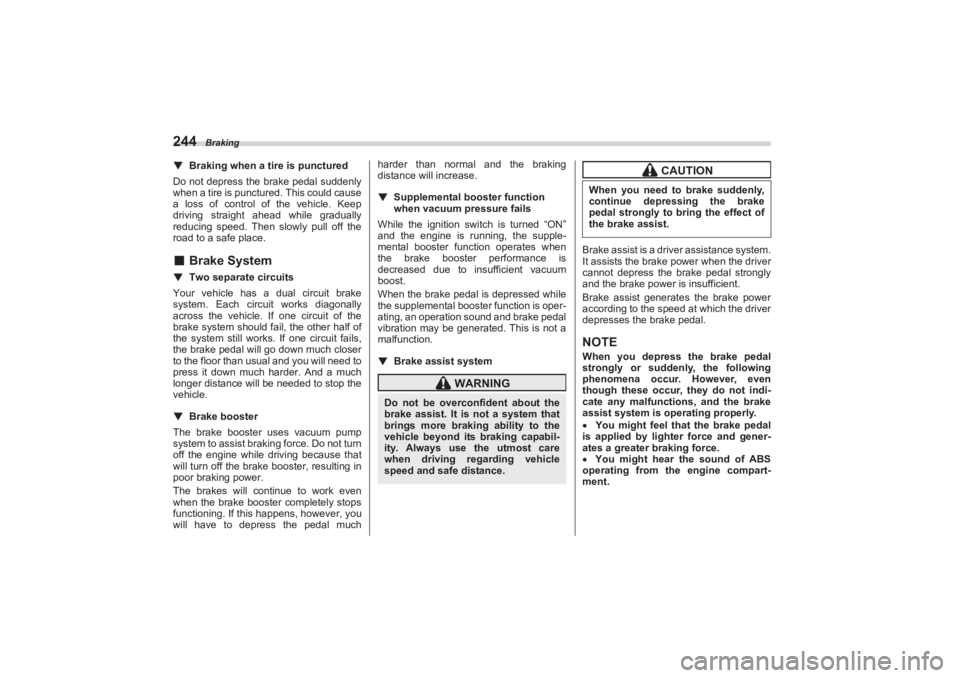
Braking
244▼Braking when a tire is punctured
Do not depress the brake pedal suddenly
when a tire is punctured. This could cause
a loss of control of the vehicle. Keep
driving straight ahead while gradually
reducing speed. Then slowly pull off the
road to a safe place.■ Brake System▼ Two separate circuits
Your vehicle has a dual circuit brake
system. Each circuit works diagonally
across the vehicle. If one circuit of the
brake system should fail, the other half of
the system still works. If one circuit fails,
the brake pedal will go down much closer
to the floor than usual and you will need to
press it down much harder. And a much
longer distance will be needed to stop the
vehicle.
▼ Brake booster
The brake booster uses vacuum pump
system to assist brakin g force. Do not turn
off the engine while driving because that
will turn off the brake booster, resulting in
poor braking power.
The brakes will continue to work even
when the brake booster completely stops
functioning. If this happens, however, you
will have to depress the pedal much harder than normal and the braking
distance will increase.
▼ Supplemental booster function
when vacuum pressure fails
While the ignition switch is turned “ON”
and the engine is running, the supple-
mental booster function operates when
the brake booster performance is
decreased due to insufficient vacuum
boost.
When the brake pedal is depressed while
the supplemental booster function is oper-
ating, an operation sound and brake pedal
vibration may be generated. This is not a
malfunction.
▼ Brake assist system
Brake assist is a driver assistance system.
It assists the brake power when the driver
cannot depress the brake pedal strongly
and the brake power is insufficient.
Brake assist generates the brake power
according to the speed at which the driver
depresses the brake pedal.NOTEWhen you depress the brake pedal
strongly or suddenly, the following
phenomena occur. However, even
though these occur, they do not indi-
cate any malfunctions, and the brake
assist system is operating properly.
You might feel that the brake pedal
is applied by lighter force and gener-
ates a greater braking force.
You might hear the sound of ABS
operating from the engine compart-
ment.
WARNING
Do not be overconfident about the
brake assist. It is not a system that
brings more braking ability to the
vehicle beyond its braking capabil-
ity. Always use the utmost care
when driving regarding vehicle
speed and safe distance.
CAUTION
When you need to brake suddenly,
continue depressing the brake
pedal strongly to bring the effect of
the brake assist.
BRZ_U.book 244 ページ 2022年3月29日 火曜日 午後3時59分
Page 251 of 432
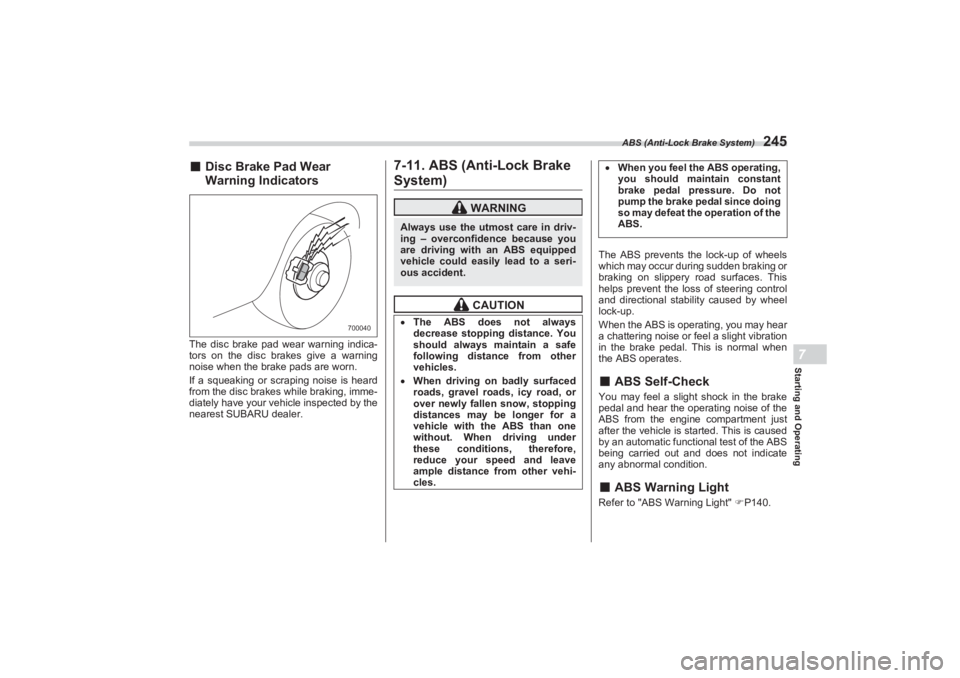
ABS (Anti-Lock Brake System)
245
Starting and Operating7
■Disc Brake Pad Wear
Wa rning IndicatorsThe disc brake pad wear warning indica-
tors on the disc brakes give a warning
noise when the brake pads are worn.
If a squeaking or scraping noise is heard
from the disc brakes while braking, imme-
diately have your vehicle inspected by the
nearest SUBARU dealer.
7-11. ABS (Anti-Lock BrakeSystem)
The ABS prevents the lock-up of wheels
which may occur during sudden braking or
braking on slippery road surfaces. This
helps prevent the loss of steering control
and directional stability caused by wheel
lock-up.
When the ABS is operating, you may hear
a chattering noise or f eel a slight vibration
in the brake pedal. This is normal when
the ABS operates.■ ABS Self-CheckYou may feel a slight shock in the brake
pedal and hear the operating noise of the
ABS from the engine compartment just
after the vehicle is started. This is caused
by an automatic functional test of the ABS
being carried out and does not indicate
any abnormal condition.■ ABS Warning LightRefer to "ABS Warning Light" P140.
700040
WARNING
Always use the utmost care in driv-
ing – overconfidence because you
are driving with an ABS equipped
vehicle could easily lead to a seri-
ous accident.
CAUTION
The ABS does not always
decrease stopping distance. You
should always maintain a safe
following distance from other
vehicles. When driving on badly surfaced
roads, gravel roads, icy road, or
over newly fallen snow, stopping
distances may be longer for a
vehicle with the ABS than one
without. When driving under
these conditions, therefore,
reduce your speed and leave
ample distance from other vehi-
cles.
When you feel the ABS operating,
you should maintain constant
brake pedal pressure. Do not
pump the brake pedal since doing
so may defeat the operation of the
ABS.
BRZ_U.book 245 ページ 2022年3月29日 火曜日 午後3時59分
Page 253 of 432

Vehicle Stability Control (VSC)/TRAC System
247
Starting and Operating7
– CONTINUED –
7-13. Vehicle Stability Control (VSC)/TRAC System■Vehicle Stability Control
(VSC) SystemIn the event of wheelspin and/or skidding
on a slippery road surface and/or during
cornering and/or an evasive maneuver,
the Vehicle Stability Control (VSC) system
adjusts the engine’s output and the
wheels’ respective braking forces to help
maintain traction and directional control.
The skid suppression function is designed
to help maintain directional stability by
suppressing the wheels’ tendency to slide
sideways during steering operations. Acti-
vation of this function is indicated by
flashing of the Vehicle Stability Control
(VSC) operation indicator light.NOTE In the following circumstances, the
vehicle may be less stable than it feels
to the driver. The Vehicle Stability
Control (VSC) system may therefore
operate. Such operation does not indi-
cate a system malfunction. - On gravel-covered or rutted
roads
- On unfinished roads
- When the vehicle is fitted with
snow tires or winter tires
Activation of the Vehicle Stability
Control (VSC) system will cause opera-
tion of the steering wheel to feel
slightly different compared to that for
normal conditions.
It is always important to reduce
speed when approaching a corner,
even if the vehicle is equipped with
Vehicle Stability Control (VSC) system.
Always turn off the engine before
replacing a tire as failure to do so may
render the Vehicle Stability Control
(VSC) system unable to operate
correctly.
■ TRAC SystemThe TRAC system is designed to prevent
spinning of the driving wheels on slippery
road surfaces, thereby helping to maintain
traction and directional control. Activation
of this function is indicated by flashing of
the Vehicle Stability Control (VSC) opera-
tion indicator light. The TRAC system is
also equipped with the brake LSD func-
tion.
WARNING
Directional control and power
may not be achievable while
driving on slippery road surfaces,
even if the TRAC system is oper-
ating. Do not drive the vehicle in
conditions where stability and
power may be lost. Always use the utmost care in
driving – overconfidence
because you are driving with a
Vehicle Stability Control (VSC)
system and TRAC system
equipped vehicle could easily
lead to a serious accident.
CAUTION
Even if your vehicle is equipped
with Vehicle Stability Control
(VSC) system and TRAC system,
winter tires should be used when
driving on snow-covered or icy
roads; in addition, vehicle speed
should be reduced considerably.
Simply having a Vehicle Stability
Control (VSC) system and TRAC
system does not guarantee that
the vehicle will be able to avoid
accidents in any situation.
BRZ_U.book 247 ページ 2022年3月29日 火曜日 午後3時59分
Page 254 of 432
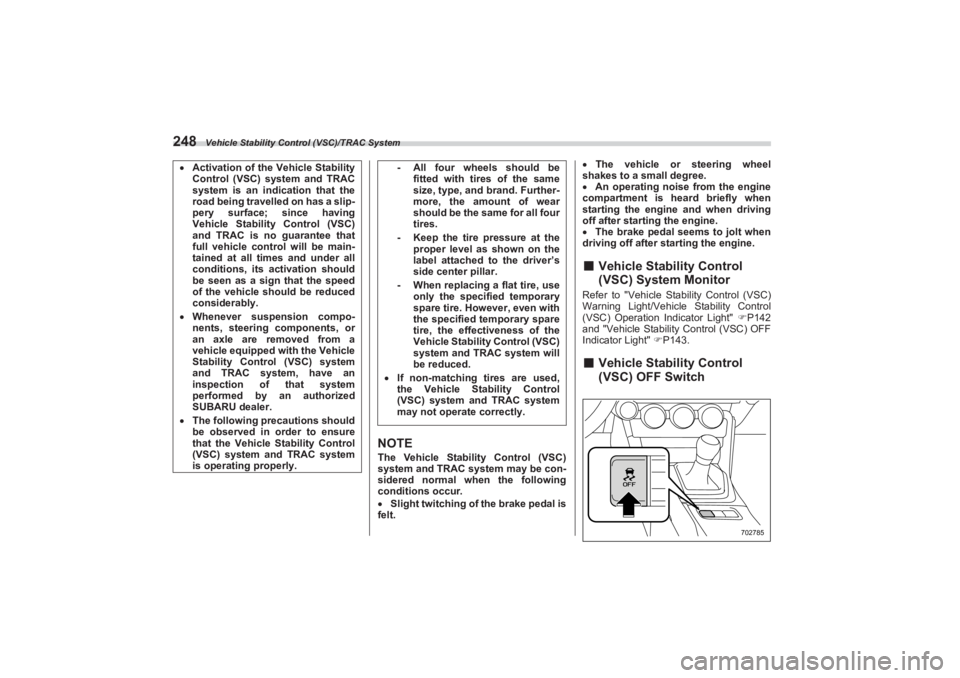
Vehicle Stability Control (VSC)/TRAC System
248
NOTEThe Vehicle Stability Control (VSC)
system and TRAC system may be con-
sidered normal when the following
conditions occur.
Slight twitching of the brake pedal is
felt.
The vehicle or steering wheel
shakes to a small degree.
An operating noise from the engine
compartment is heard briefly when
starting the engine and when driving
off after starti ng the engine.
The brake pedal seems to jolt when
driving off after st arting the engine.
■Vehicle Stability Control
(VSC) System MonitorRefer to "Vehicle Stability Control (VSC)
Warning Light/Vehicle Stability Control
(VSC) Operation Indicator Light" P142
and "Vehicle Stability Control (VSC) OFF
Indicator Light" P143.■ Vehicle Stability Control
(VSC) OFF Switch
Activation of the Vehicle Stability
Control (VSC) system and TRAC
system is an indication that the
road being travelled on has a slip-
pery surface; since having
Vehicle Stability Control (VSC)
and TRAC is no guarantee that
full vehicle control will be main-
tained at all times and under all
conditions, its activation should
be seen as a sign that the speed
of the vehicle should be reduced
considerably. Whenever suspension compo-
nents, steering components, or
an axle are removed from a
vehicle equipped with the Vehicle
Stability Control (VSC) system
and TRAC system, have an
inspection of that system
performed by an authorized
SUBARU dealer. The following precautions should
be observed in order to ensure
that the Vehicle Stability Control
(VSC) system and TRAC system
is operating properly.
- All four wheels should be
fitted with tires of the same
size, type, and brand. Further-
more, the amount of wear
should be the same for all four
tires.- Keep the tire pressure at the
proper level as shown on the
label attached to the driver’s
side center pillar.- When replacing a flat tire, use
only the specified temporary
spare tire. However, even with
the specified temporary spare
tire, the effectiveness of the
Vehicle Stability Control (VSC)
system and TRAC system will
be reduced.
If non-matching tires are used,
the Vehicle Stability Control
(VSC) system and TRAC system
may not operate correctly.
702785
BRZ_U.book 248 ページ 2022年3月29日 火曜日 午後3時59分
Page 255 of 432

Vehicle Stability Control (VSC)/TRAC System
249
Starting and Operating7
– CONTINUED –
▼Disabling the TRAC System
If the vehicle gets stuck in mud, dirt or
snow, the TRAC system may reduce
power from the engine to the wheels.
Pressing the Vehicle Stability Control
(VSC) OFF switch to turn the system off
may make it easier for you to rock the
vehicle in order to free it. In this case, the
brake LSD function remains on. To turn
the TRAC system off, quickly press and
release the button. The TRAC OFF indi-
cator light will come on. Press the button
again to turn the system back on.
Creating adequate driving wheel slip by
deactivating the TRAC system may help
to recover from the loss of traction. Use
the Vehicle Stability Control (VSC) OFF
switch as necessary.
A standing start on a steeply sloping
road with a snowy, gravel-covered, or
otherwise slippery surface
Extrication of the vehicle when its
wheels are stuck in mud or deep snow ▼
Turning Off both Vehicle Stability
Control (VSC) and TRAC Systems
To turn the Vehicle Stability Control (VSC)
systems and TRAC system off, press and
hold the Vehicle Stability Control (VSC)
OFF switch for more than 3 seconds while
the vehicle is stopped. The TRAC OFF
indicator light and the Vehicle Stability
Control (VSC) OFF indicator light will
come on. However, on vehicles with an
automatic transmissi on, the brake LSD
function will remain on. Press the button
again to turn the systems back on. With
the Vehicle Stability Control (VSC) system
and TRAC system deactivated, traction
and stability enhancement offered by
Vehicle Stability Control (VSC) system
and TRAC system is unavailable. There-
fore you should not deactivate the Vehicle Stability Control (VSC) system and TRAC
system except under above-mentioned
situations.
NOTE When the switch has been pressed
to deactivate the Vehicle Stability
Control (VSC) system and TRAC
system, the Vehicle Stability Control
(VSC) system and TRAC system auto-
matically reactivates itself the next
time the ignition swit ch is turned to the
“OFF” position and the engine is
restarted.
If the switch is held down for 30
seconds or longer, the indicator light
turns off, the Vehicle Stability Control
(VSC) system is activated, and the
system ignores any further pressing of
the switch. To make the switch usable
again, turn the ignition switch to the
“OFF” position and restart the engine.
When the switch is pressed to deac-
tivate the Vehicle Stability Control
(VSC) system and TRAC system, the
vehicle’s running performance is
comparable with that of a vehicle that
does not have a Vehicle Stability
Control (VSC) system and TRAC
system. Do not deac tivate the Vehicle
Stability Control (VSC) system and
TRAC system except when absolutely
necessary.
702831
BRZ_U.book 249 ページ 2022年3月29日 火曜日 午後3時59分